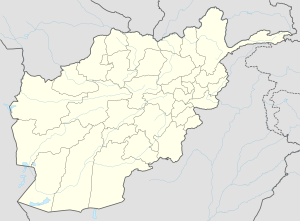
Back شاريكار Arabic شاريكار ARZ Çarikar AZ চরিকর Bengali/Bangla Charikar Catalan Charikar (kapital sa lalawigan sa Nasod nga Afghano) CEB Čáríkár Czech Charikar Danish Tscharikar German Τσαρικάρ Greek
Imam Abu Hanifa
امام ابو حنیفه Charikar Imam Azam | |
|---|---|
City | |
 A street in Charikar during the War in Afghanistan, 2007 | |
| Coordinates: 35°0′47″N 69°10′8″E / 35.01306°N 69.16889°E | |
| Country | |
| Province | Parwan Province |
| District | Charikar District |
| Elevation | 1,600 m (5,200 ft) |
| Population (2015) | |
• City | 96,093[1] |
| • Urban | 96,039[2] |
| Time zone | UTC+4:30 |

Charikar (Persian: چاریکار), officially renamed to Imam Abu Hanifa[3] (Persian: امام ابو حنیفه) or Imam Azam (Persian: امام اعظم, Persian pronunciation: [ɪˈmɑːm azam]),[4] is the main town of the Koh Daman Valley[clarification needed]. It is the capital of Charikar District, and the capital of Parwan Province in northern Afghanistan. It has a population of around 171,200,[5] which is majority Tajik populated.[6][7] The town was officially renamed in December 2022 by the Taliban to honor the 8th-century Sunni Muslim theologian and jurist Abu Hanifa,[3] who is also sometimes called Imam Azam ("The Great Imam")[4] and was the founder of the Hanafi school of Islamic law.
The city lies on the Afghan Ring Road, 69 kilometres (43 mi) from Kabul along the route to the northern provinces. Travelers would pass the city when traveling to Mazar-i-Sharif, Kunduz or Puli Khumri. Despite the proximity to Kabul, slightly more than half of the land is not built-up. Of the built-up land, almost equal parts are residential (37%) and vacant plots (32%), with a grid network of road coverage amounting to 19% of built-up land area, as of 2015[update].[8] The city is at the gateway to the Panjshir Valley, where the Shamali plains meet the foothills of the Hindu Kush, and is known for its pottery and high-quality grapes.[9]
As of 2015[update], the city has a total population of 96,039 people and 10,671 dwellings. It has four police districts (nahias) and a total land area of 3,025 hectares (11.68 sq mi).[8]
- ^ "The State of Afghan Cities Report 2015". Archived from the original on 31 October 2015. Retrieved 21 October 2015.
- ^ "The State of Afghan Cities Report 2015". Archived from the original on 31 October 2015. Retrieved 21 October 2015.
- ^ a b Rezahi, Nizamuddin (17 December 2022). "Massive Reactions to Changing the Name of 'Charikar' into 'Imam Abu Hanifa'". The Khaama Press News Agency. Retrieved 2022-12-24.
- ^ a b "Parwan capital's name changed from Charikar to Imam Azam". Ariana News. 16 December 2022.
- ^ "Settled Population of Parwan province by Civil Division, Urban, Rural and Sex-2012-13" (PDF). Islamic Republic of Afghanistan, Central Statistics Organization. Archived from the original (PDF) on 2013-12-16. Retrieved 2013-06-16.
- ^ "Parwan Province". Program for Culture & Conflict Studies. Naval Postgraduate School. Archived from the original on 2021-11-07. Retrieved 2013-06-16.
The population of approximately 560,000 is composed of Pashtun, Tajik, Uzbek, Qizilbash, Kuchi, Hazara, and other minority groups.
- ^ "Regional Command East: Parwan Province". Institute for the Study of War. Retrieved 2013-06-16.
The main ethnic groups are Pashtuns and Tajiks, but there are small numbers of Uzbeks, Qizilbash and Hazaras as well.
- ^ a b "The State of Afghan Cities Report 2015". Archived from the original on 31 October 2015. Retrieved 20 October 2015.
- ^ Cite error: The named reference
ColumbiaEncyclopediawas invoked but never defined (see the help page).
